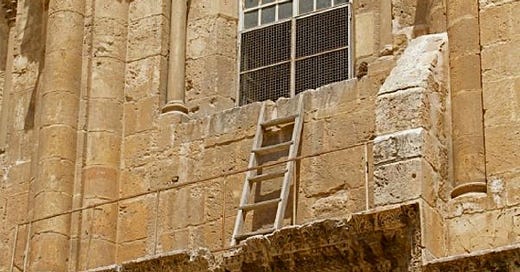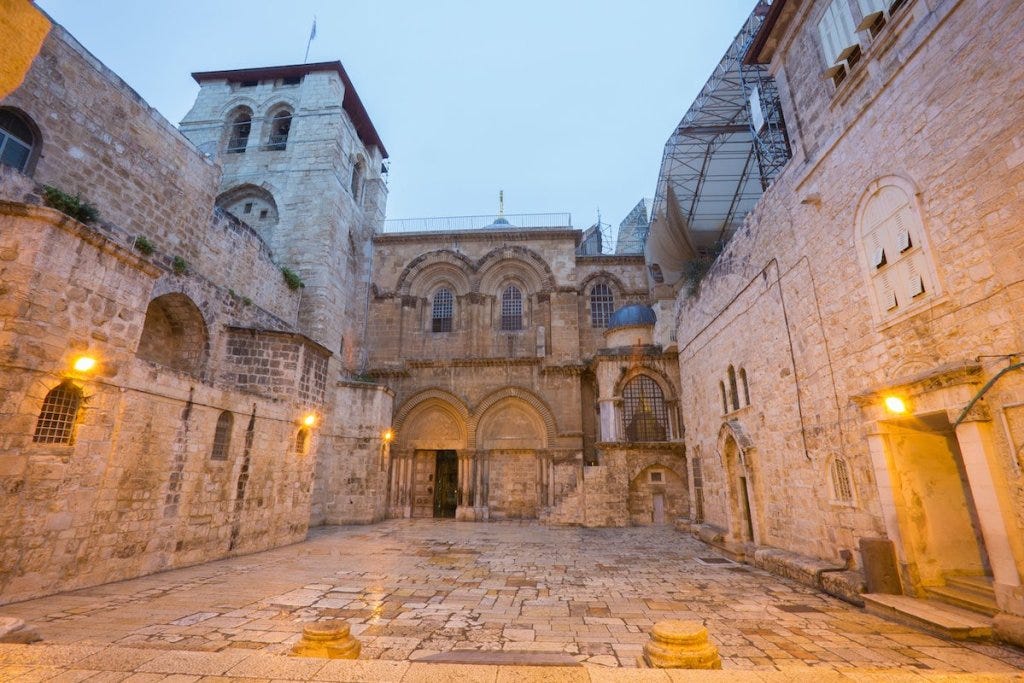In the heart of Jerusalem's Old City stands the Church of the Holy Sepulchre, a 4th-century edifice steeped in history and religious significance. But it's not the ancient stones or sacred relics that catch the eye of many visitors. Instead, it's a simple wooden ladder perched on a ledge above the entrance – a ladder that hasn't moved in centuries and, if things remain as they are, may never move again.
This seemingly unremarkable object, known as the "immovable ladder," tells a fascinating tale of religious division, historical quirks, and the delicate balance of power in one of Christianity's holiest sites. But how did a mere ladder become such a potent symbol?
To understand, we must journey back to the 18th century when Jerusalem was under Ottoman rule. In 1757, the Ottoman Sultan issued a decree that would have far-reaching consequences. This firman, as it was called, preserved the ownership of Jerusalem's holy sites to their current owners. For the Church of the Holy Sepulchre, this meant cementing a complex arrangement between six Christian denominations: Greek Orthodox, Armenian Apostolic, Roman Catholic, Coptic Orthodox, Syriac Orthodox, and Ethiopian Orthodox.
The Sultan's decree led to an understanding among these groups that nothing in the church could be changed without the unanimous approval of all six orders. It was a well-intentioned attempt at maintaining peace, but it inadvertently created a state of perpetual stasis.
Enter the ladder. No one knows exactly how or when it appeared, but engravings from 1728 show it was already in place by then. Most speculate that a mason left it there after completing some repair work. The problem? No one knows which denomination the mason belonged to, making the ladder's ownership as murky as the waters of the nearby Dead Sea.
This uncertainty has transformed the ladder into a shared property of all six denominations. And here's where the plot thickens: moving it would require the agreement of all six groups, a consensus about as likely as water flowing uphill.
The ladder's immobility isn't just a quirk of history; it's a reflection of the deep-seated divisions within Christianity. These fractures occasionally erupt into physical confrontations. In 2002, a Coptic monk moved a chair slightly to sit in the shade, inadvertently sparking a fistfight that left a dozen monks injured. A similar violent event happened again in 2008 when the Armenian monks were holding a ceremony and wouldn't allow a Greek monk to participate with them.
Given this context, it's no wonder that Pope Paul VI issued a pontifical order in 1964 stating that the ladder should remain in place until the Catholic and Orthodox churches achieve unity. It was a gesture towards reconciliation, but it also ensured that, at least from the Catholic perspective, the ladder won't be going anywhere anytime soon.
Despite its "immovable" moniker, the ladder has been moved a few times. In 1997, a prankster actually stole it, causing tensions to flare between the religious communities. Feeling remorseful, the thief returned it weeks later. In 2009, it was temporarily moved for cleaning – a rare moment of agreement among the denominations.
The immovable ladder serves as a poignant metaphor for the challenges of interfaith cooperation. It stands as a silent witness to centuries of religious history, a humble wooden object that encapsulates the complexities of human belief and the power of tradition.
As visitors gaze up at this unassuming ladder, they might ponder: What would it take for this symbol of division to become a catalyst for unity? Could this simple tool, designed to help people reach higher places, eventually help these diverse faith communities find common ground?
In the meantime, the ladder remains, a testament to the enduring power of history and the intricate web of agreements that govern Jerusalem's holiest sites. It continues to spark curiosity, debate, and reflection, proving that sometimes, the most mundane objects can tell the most extraordinary stories.




